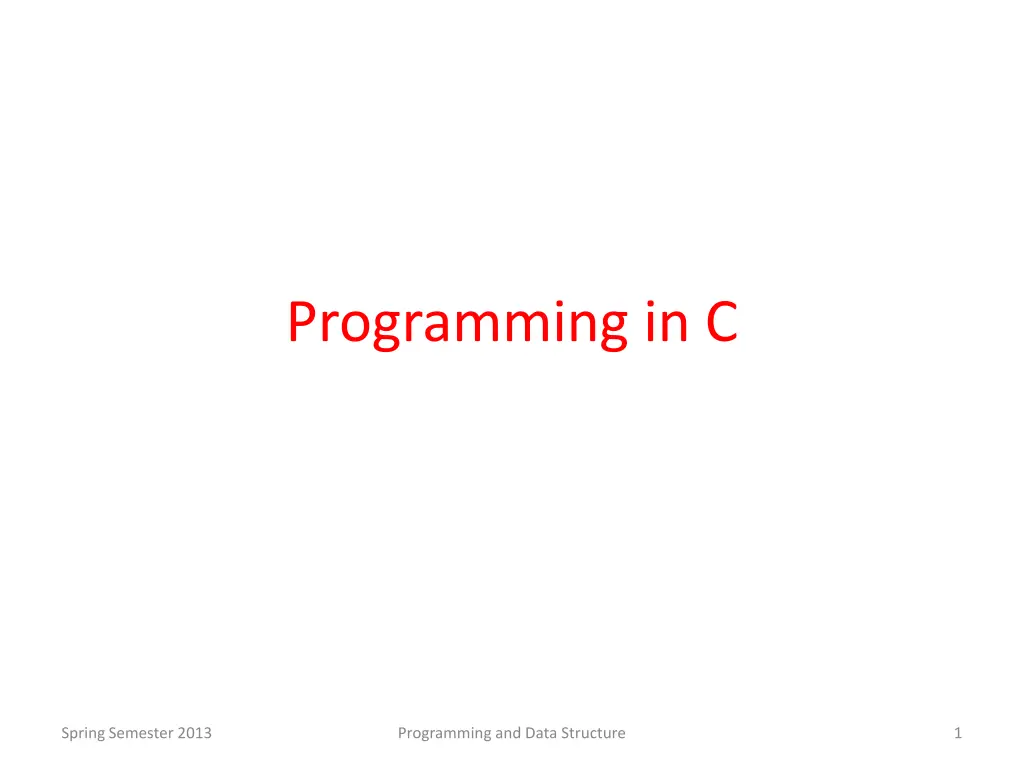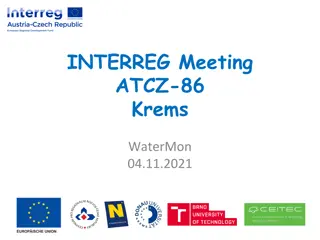
Understanding Programming in C: Spring Semester 2013 Overview
Dive into the world of programming with an exploration of C in the Spring Semester of 2013. Learn about the history, structure, and sample programs in C, as well as its features and uses. Discover the fundamentals of this versatile and portable programming language.
Download Presentation

Please find below an Image/Link to download the presentation.
The content on the website is provided AS IS for your information and personal use only. It may not be sold, licensed, or shared on other websites without obtaining consent from the author. If you encounter any issues during the download, it is possible that the publisher has removed the file from their server.
You are allowed to download the files provided on this website for personal or commercial use, subject to the condition that they are used lawfully. All files are the property of their respective owners.
The content on the website is provided AS IS for your information and personal use only. It may not be sold, licensed, or shared on other websites without obtaining consent from the author.
E N D
Presentation Transcript
Programming in C Spring Semester 2013 Programming and Data Structure 1
Introduction to C C is a general-purpose, structured programming language. Resembles other high-level structured programming languages, such as Pascal and Fortran-77. Also contains additional features which allow it to be used at a lower level. C can be used for applications programming as well as for systems programming. There are only 32 keywords and its strength lies in its built-in functions. C is highly portable, since it relegated much computer- dependent features to its library functions. Spring Semester 2013 Programming and Data Structure 2
History of C Originally developed in the 1970 s by Dennis Ritchie at AT&T Bell Laboratories. Outgrowth of two earlier languages BCPL and B. Popularity became widespread by the mid 1980 s, with the availability of compilers for various platforms. Standardization has been carried out to make the various C implementations compatible. American National Standards Institute (ANSI) GNU Spring Semester 2013 Programming and Data Structure 3
Structure of a C program Every C program consists of one or more functions. One of the functions must be called main. The program will always begin by executing the main function. Each function must contain: A function heading, which consists of the function name, followed by an optional list of arguments enclosed in parentheses. A list of argument declarations. A compound statement, which comprises the remainder of the function. Spring Semester 2013 Programming and Data Structure 4
Contd. Each compound statement is enclosed within a pair of braces: { and } The braces may contain combinations of elementary statements and other compound statements. Comments may appear anywhere in a program, enclosed within delimiters /* and */ . Example: a = b + c; /* ADD TWO NUMBERS */ Spring Semester 2013 Programming and Data Structure 5
Sample C program #1 Header file includes functions for input/output #include <stdio.h> Main function is executed when you run the program. (Later we will see how to pass its parameters) main() { printf ( \n Our first look at a C program \n ); } Curly braces within which statements are executed one after another. Statement for printing the sentence within double quotes ( .. ). \n denotes end of line. Our first look at a C program Spring Semester 2013 Programming and Data Structure 6
Sample C program #2 #include <stdio.h> main() { int a, b, c; a = 10; b = 20; c = a + b; printf ( \n The sum of %d and %d is %d\n , a,b,c); } Integers variables declared before their usage. Control character for printing value of a in decimal digits. The sum of 10 and 20 is 30 Spring Semester 2013 Programming and Data Structure 7
Sample C program #3 #include <stdio.h> Comments within /* .. */ /* FIND THE LARGEST OF THREE NUMBERS */ main() { int a, b, c; scanf ( %d %d %d , &a, &b, &c); if ((a>b) && (a>c)) /* Composite condition check */ printf ( \n Largest is %d , a); else if (b>c) /* Simple condition check */ printf ( \n Largest is %d , b); else printf ( \n Largest is %d , c); } Input statement for reading three variables from the keyboard Conditional statement Spring Semester 2013 Programming and Data Structure 8
Sample C program #4 Preprocessor statement. Replace PI by 3.1415926 before compilation. Example of a function Called as per need from Main programme. #include <stdio.h> #define PI 3.1415926 float myfunc (float r) { float a; a = PI * r * r; return (a); /* return result */ } /* Compute the area of a circle */ main() { float radius, area; float myfunc (float radius); scanf ( %f , &radius); area = myfunc (radius); printf ( \n Area is %f \n , area); } Function called. Spring Semester 2013 Programming and Data Structure 9
main() is also a function #include <stdio.h> main() { int a, b, c; a = 10; b = 20; c = a + b; printf ( \n The sum of %d and %d is %d\n , a,b,c); } Spring Semester 2013 Programming and Data Structure 10
Desirable Programming Style Clarity The program should be clearly written. It should be easy to follow the program logic. Meaningful variable names Make variable/constant names meaningful to enhance program clarity. area instead of a radius instead of r Program documentation Insert comments in the program to make it easy to understand. Never use too many comments. Spring Semester 2013 Programming and Data Structure 11
Contd. Program indentation Use proper indentation. Structure of the program should be immediately visible. Spring Semester 2013 Programming and Data Structure 12
Indentation Example #1 :: Good Style #include <stdio.h> #define PI 3.1415926 /* Compute the area of a circle */ float myfunc (float r) { float a; a = PI * r * r; return (a); /* return result */ } main() { float radius, area; float myfunc (float radius); scanf ( %f , &radius); area = myfunc (radius); printf ( \n Area is %f \n , area); } Spring Semester 2013 Programming and Data Structure 13
Indentation Example #1 :: Bad Style #include <stdio.h> #define PI 3.1415926 /* Compute the area of a circle */ main() { float radius, area; float myfunc (float radius); scanf ( %f , &radius); area = myfunc (radius); printf ( \n Area is %f \n , area); } float myfunc (float r) { float a; a = PI * r * r; return (a); /* return result */ } Spring Semester 2013 Programming and Data Structure 14
Indentation Example #2 :: Good Style #include <stdio.h> /* FIND THE LARGEST OF THREE NUMBERS */ main() { int a, b, c; scanf ( %d %d %d , &a, &b, &c); if ((a>b) && (a>c)) /* Composite condition check */ printf ( \n Largest is %d , a); else if (b>c) /* Simple condition check */ printf ( \n Largest is %d , b); else printf ( \n Largest is %d , c); } Spring Semester 2013 Programming and Data Structure 15
Indentation Example #2 :: Bad Style #include <stdio.h> /* FIND THE LARGEST OF THREE NUMBERS */ main() { int a, b, c; scanf ( %d %d %d , &a, &b, &c); if ((a>b) && (a>c)) /* Composite condition check */ printf ( \n Largest is %d , a); else if (b>c) /* Simple condition check */ printf ( \n Largest is %d , b); else printf ( \n Largest is %d , c); } Spring Semester 2013 Programming and Data Structure 16
The C Character Set The C language alphabet: Uppercase letters A to Z Lowercase letters a to z Digits 0 to 9 Certain special characters: ! # % ^ & * ( ) - _ + = ~ [ ] \ | ; : { } , . < > / ? blank Spring Semester 2013 Programming and Data Structure 17
Identifiers and Keywords Identifiers Names given to various program elements (variables, constants, functions, etc.) May consist of letters, digits and the underscore ( _ ) character, with no space between. First character must be a letter. An identifier can be arbitrary long. Some C compilers recognize only the first few characters of the name (16 or 31). Case sensitive area , AREA and Area are all different. Spring Semester 2013 Programming and Data Structure 18
Contd. Keywords Reserved words that have standard, predefined meanings in C. Cannot be used as identifiers. OK within comments. Standard C keywords: double else enum extern float for goto if auto break case char const continue default do int long register return short signed sizeof static struct switch typedef union unsigned void volatile while Spring Semester 2013 Programming and Data Structure 19
Valid and Invalid Identifiers Valid identifiers X abc simple_interest a123 LIST stud_name Empl_1 Empl_2 avg_empl_salary Invalid identifiers 10abc my-name hello simple interest (area) %rate Spring Semester 2013 Programming and Data Structure 20
Data Types in C int :: integer quantity Typically occupies 4 bytes (32 bits) in memory. char :: single character Typically occupies 1 byte (8 bits) in memory. float :: floating-point number (a number with a decimal point) Typically occupies 4 bytes (32 bits) in memory. double :: double-precision floating-point number Spring Semester 2013 Programming and Data Structure 21
Contd. Some of the basic data types can be augmented by using certain data type qualifiers: short long signed unsigned Typical examples: short int long int unsigned int Spring Semester 2013 Programming and Data Structure 22
Some Examples of Data Types int 0, 25, -156, 12345, 99820 char a , A , * , / , float 23.54, 0.00345, 25.0 2.5E12, 1.234e-5 E or e means 10 to the power of Spring Semester 2013 Programming and Data Structure 23
Constants Constants Numeric Constants Character Constants integer floating-point single character string Spring Semester 2013 Programming and Data Structure 24
Integer Constants Consists of a sequence of digits, with possibly a plus or a minus sign before it. Embedded spaces, commas and non-digit characters are not permitted between digits. Maximum and minimum values (for 32-bit representations) Maximum :: 2147483647 Minimum :: 2147483648 Spring Semester 2013 Programming and Data Structure 25
Floating-point Constants Can contain fractional parts. Very large or very small numbers can be represented. 23000000 can be represented as 2.3e7 Two different notations: 1. Decimal notation 25.0, 0.0034, .84, -2.234 2. Exponential (scientific) notation 3.45e23, 0.123e-12, 123E2 e means 10 to the power of Spring Semester 2013 Programming and Data Structure 26
Single Character Constants Contains a single character enclosed within a pair of single quote marks. Examples :: 2 , + , Z Some special backslash characters \n new line \t horizontal tab \ single quote \ double quote \\ backslash \0 null Spring Semester 2013 Programming and Data Structure 27
String Constants Sequence of characters enclosed in double quotes. The characters may be letters, numbers, special characters and blank spaces. Examples: nice , Good Morning , 3+6 , 3 , C Differences from character constants: C and C are not equivalent. C has an equivalent integer value while C does not. Spring Semester 2013 Programming and Data Structure 28
Variables It is a data name that can be used to store a data value. Unlike constants, a variable may take different values in memory during execution. Variable names follow the naming convention for identifiers. Examples :: temp, speed, name2, current Spring Semester 2013 Programming and Data Structure 29
Example int a, b, c; char x; Variables a = 3; b = 50; c = a b; x = d ; b = 20; a = a + 1; x = G ; Constants Spring Semester 2013 Programming and Data Structure 30
Declaration of Variables There are two purposes: 1. It tells the compiler what the variable name is. 2. It specifies what type of data the variable will hold. General syntax: data-type variable-list; Examples: int velocity, distance; int a, b, c, d; float temp; char flag, option; Spring Semester 2013 Programming and Data Structure 31
A First Look at Pointers A variable is assigned a specific memory location. For example, a variable speed is assigned memory location 1350. Also assume that the memory location contains the data value 100. When we use the name speed in an expression, it refers to the value 100 stored in the memory location. distance = speed * time; Thus every variable has an address (in memory), and its contents. Spring Semester 2013 Programming and Data Structure 32
Adress and Content int speed; speed speed=100; 1349 100 1350 1351 speed 100 &speed 1352 1350 Spring Semester 2013 Programming and Data Structure 33
Contd. In C terminology, in an expression speed refers to the contents of the memory location. &speed refers to the address of the memory location. Examples: printf ( %f %f %f , speed, time, distance); scanf ( %f %f , &speed, &time); Spring Semester 2013 Programming and Data Structure 34
An Example #include <stdio.h> main() { float speed, time, distance; Address of speed scanf ( %f %f , &speed, &time); distance = speed * time; printf ( \n The distance traversed is: \n , distance); } Content of speed Spring Semester 2013 Programming and Data Structure 35
Assignment Statement Used to assign values to variables, using the assignment operator (=). General syntax: variable_name = expression; Examples: velocity = 20; b = 15; temp = 12.5; A = A + 10; v = u + f * t; s = u * t + 0.5 * f * t * t; Spring Semester 2013 Programming and Data Structure 36
Contd. A value can be assigned to a variable at the time the variable is declared. int speed = 30; char flag = y ; Several variables can be assigned the same value using multiple assignment operators. a = b = c = 5; flag1 = flag2 = y ; speed = flow = 0.0; Spring Semester 2013 Programming and Data Structure 37
Operators in Expressions Operators Arithmetic Operators Relational Operators Logical Operators Spring Semester 2013 Programming and Data Structure 38
Arithmetic Operators Addition :: Subtraction :: Division :: Multiplication :: Modulus :: + / * % Spring Semester 2013 Programming and Data Structure 39
Examples distance = rate * time ; netIncome = income - tax ; speed = distance / time ; area = PI * radius * radius; y = a * x * x + b*x + c; quotient = dividend / divisor; remain =dividend % divisor; Spring Semester 2013 Programming and Data Structure 40
Contd. Suppose x and y are two integer variables, whose values are 13 and 5 respectively. x + y 18 x y 8 x * y 65 x / y 2 x % y 3 Spring Semester 2013 Programming and Data Structure 41
Operator Precedence In decreasing order of priority 1. Parentheses :: ( ) 2. Unary minus :: 5 3. Multiplication, Division, and Modulus 4. Addition and Subtraction For operators of the same priority, evaluation is from left to right as they appear. Parenthesis may be used to change the precedence of operator evaluation. Spring Semester 2013 Programming and Data Structure 42
Examples: Arithmetic expressions a + (b * c) (d / e) a * ( b) + (d % e) f (((a b) + c) + d) ((x * y) * z) (a + b) + ((c * d) * e) a + b * c d / e a * b + d % e f a b + c + d x * y * z a + b + c * d * e Spring Semester 2013 Programming and Data Structure 43
Integer Arithmetic When the operands in an arithmetic expression are integers, the expression is called integer expression, and the operation is called integer arithmetic. Integer arithmetic always yields integer values. Spring Semester 2013 Programming and Data Structure 44
Real Arithmetic Arithmetic operations involving only real or floating-point operands. Since floating-point values are rounded to the number of significant digits permissible, the final value is an approximation of the final result. 1.0 / 3.0 * 3.0 will have the value 0.99999 and not 1.0 The modulus operator cannot be used with real operands. Spring Semester 2013 Programming and Data Structure 45
Mixed-mode Arithmetic When one of the operands is integer and the other is real, the expression is called a mixed- mode arithmetic expression. If either operand is of the real type, then only real arithmetic is performed, and the result is a real number. 25 / 10 2 25 / 10.0 2.5 Some more issues will be considered later. Spring Semester 2013 Programming and Data Structure 46
Problem of value assignment Assignment operation variable= expression_value; or variable1=variable2; Data type of the RHS should be compatible with that of LHS. e.g. four byte floating point number is not allowed to be assigned to a two byte integer variable. Spring Semester 2013 Programming and Data Structure 47
Type Casting int x; float r=3.0; Type casting of a floating point expression to an integer variable. x= (int)(2*r); Type casting to double double perimeter; float pi=3.14; int r=3; perimeter=2.0* (double) pi * (double) r; Spring Semester 2013 Programming and Data Structure 48
Relational Operators Used to compare two quantities. < is less than > is greater than <= is less than or equal to >= is greater than or equal to == is equal to != is not equal to Spring Semester 2013 Programming and Data Structure 49
Examples 10 > 20 25 < 35.5 12 > (7 + 5) is false is true is false When arithmetic expressions are used on either side of a relational operator, the arithmetic expressions will be evaluated first and then the results compared. a + b > c d is the same as (a+b) > (c+d) Spring Semester 2013 Programming and Data Structure 50






















